 Sold
Sold
Idleness in the Dunes
SULPIS, Emile Jean
Farniente dans les Dunes (descriptive French title) Etching and aquatint printed in gold and yellow,colored with colored pencil and graphite on wov...
View full detailsÉmile-Jean Sulpis (May 22, 1856 -December 31, 1942) is today mostly remembered as an etcher-engraver. His father, Jean-Joseph Sulpis, was an architectural engraver, who likely taught his son most technical aspects of the trade, as used to be the tradition. Sulpis “son” received further formal trailing in the studios of Alexandre Cabanel and Louis-Pierre Henriquet Dupont. Today mostly forgotten, Sulpis started, like his father, etching for illustrations of books and other publications. He was exacting, and could render textures with very fine lines in a way that few could. He is known to have collaborated on a book devoted to Japanese jade with Henri Guérard. After 1900 Sulpis increasingly used his own imagination to create etched compositions in states which he liked to rework, and often hand colored. He mostly etched on a smaller scale. His compositions are charming and unusual in their frequent use of metallic inks.
Sulpis was well known in his time, having exhibited at the Paris “Salon des Artistes Français” from 1880 (awarded hors-concours in 1890). He was “Prix de Rome” in 1884; and received distinctions at the salons: commendation in 1890; silver medal in 1892; gold medal in 1894. He won the “Grand Prix” at the “Exposition Universelle” of 1900 and was awarded a medal of honor in 1905; was made “Chevalier de la Légion d'Honneur” in 1900; and finally became a member of the “Académie des Beaux-Arts” in 1911.
 Sold
Sold
Farniente dans les Dunes (descriptive French title) Etching and aquatint printed in gold and yellow,colored with colored pencil and graphite on wov...
View full detailsPlease sign up for our newsletter
Email: info@armstrongfineart.com
Phone: 773-887-6776
1200 West 35th Street, #186
Chicago, IL 60609
Copyright © 2026 Armstrong Fine Art.
Development by Alo Agency. Powered by Shopify
